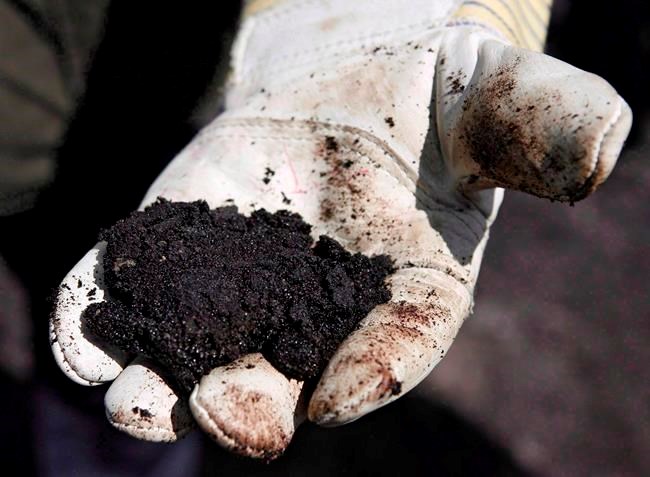EDMONTON — Alberta has come to an agreement with the federal government that makes major cuts to environmental monitoring of the oilsands.
The deal, a copy of which has been obtained by The Canadian Press, lays out research plans for this year's field season under a federal-provincial program that oversees all monitoring of the area outside of company leases.
Signed July 7 by top bureaucrats in Ottawa and Edmonton, it reduces funding by about 25 per cent from last year's budget. This year's budget has been cut to no more than $44 million. The approved budget was $58 million in 2019-20 — although about $52 million was spent.
The deal says no fieldwork is to be done on the main branch of the Athabasca River. That means the program won't fund monitoring downstream of the oilsands even as the province considers proposals to allow the water from oilsands tailings ponds to be released into the river.
The agreement also says there'll be no field studies on wetlands, fish or insects.
A pilot project gauging the risks posed by tailings ponds has been dropped. Water quality assessment in Wood Buffalo National Park — part of a response to international concerns about environmental degradation at the UNESCO World Heritage Site — is gone.
Under the deal, administrative costs have ballooned to more than $10 million from about $7 million last year. That means nearly one-quarter of the monitoring budget will be spent before a single data point is collected.
A federal official said Tuesday that much of the budget cut is due to the pandemic.
"We have missed part of the field season," said Kevin Cash, acting assistant deputy minister of science and technology with Environment and Climate Change Canada.
He said a substantial part of the spring and summer season was lost, which makes up most of the reduction in costs.
Cash added that the decision to cut the budget was made by a 12-person oversight committee that includes six people from Indigenous communities, as well as representatives from industry and the provincial and federal governments.
The monitoring program, initiated in 2012 under Stephen Harper's Conservative government, funds research by outside organizations as well as government scientists.
Between March and the middle of July, Alberta's United Conservative government and the province's energy regulator also suspended a wide array of monitoring activities required of oilsands companies as conditions of their operating licences. The pandemic was cited as a reason for the suspensions.
Jess Sinclair, press secretary for Alberta Environment Minister Jason Nixon, said in an email Tuesday that budgeted funding does not relfect what is actually spent and the funding amount this year is in line with average spending in previous years.
"The $43.9 million approved for oilsands monitoring in 2020-21 reflects the expected costs of monitoring required to assure immediate public and environmental health, long-term monitoring and focused activities across the areas of air, water, wetlands, wildlife and vegetation monitoring," she said.
Jim Herbers of the Alberta Biodiversity Monitoring Institute says his funding was cut to $1.4 million from the usual $4 million to $5 million.
"Field monitoring is the biggest component of what we're not going to be doing this year," he said.
"The work around monitoring for amphibians, birds and mammals, that work won't be undertaken. Nor will work on tracking indicators related to plants or changes in habitat."
Herbers said he was told the cuts were made to protect workers from COVID-19.
Bill Donahue, a former senior civil servant with Alberta's science and monitoring programs, said leaving the Athabasca River unmonitored is "crazy."
"We've got one of the biggest industrial developments — the primary problems of which are contamination of the environment and consumption of water — and there's no downstream monitoring."
The federal official said it's an "evolving issue" and some water quality monitoring could resume as COVID-19 restrictions are eased.
Alberta has a binding agreement with the Northwest Territories to keep track of what's happening with the Athabasca, which flows into the territory. Joslyn Oosenbrug of the territory's Environment Department said her government was told a deal had been reached.
"We were not provided with any detailed information about the budget," she said in an email.
"The (territory) has made its concerns known about the suspension of water quality monitoring in Alberta and continues to advocate for all monitoring to resume, especially the (oilsands monitoring) program."
Marlin Schmidt, environment critic for Alberta's NDP Opposition, pointed out the provincial budget set aside at least $50 million for monitoring paid for through an industry levy.
"I feel I've been lied to," he said.
He said the cuts aren't likely to help the image of Alberta's industry.
"It's critical to protect the environment. It's also critical to show the world we can develop these resources responsibly. We're failing at both."
This report by The Canadian Press was first published Aug. 4, 2020
— With files from Colette Derworiz. Follow Bob Weber on Twitter at @row1960
Bob Weber, The Canadian Press




